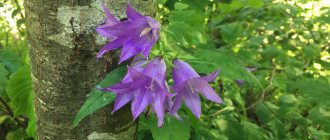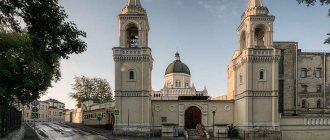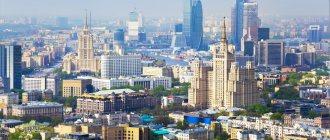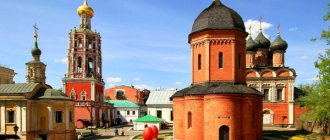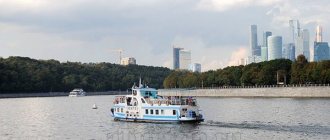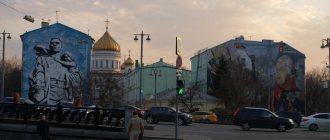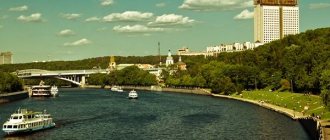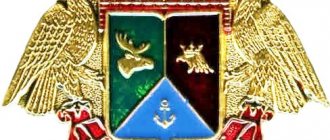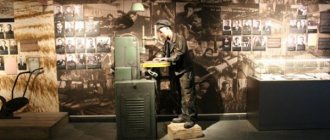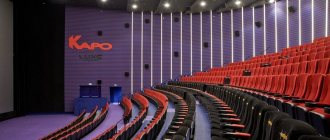Orthodox churches and monasteries in Moscow
The modern capital of Russia is not the oldest city in the country, but it has preserved many ancient temples. Now Moscow shines with the domes of new monasteries, and the old ones after restoration do not differ from the newly erected ones.
Cathedral of Christ the Savior
The young temple can be called the heart of the city. It was built back in the 19th century, but it was completely destroyed by the Bolsheviks. Restoration began only after perestroika. Sightseeing tours of this temple are currently being conducted. It is located on the street. Volkhonka 15, the nearest metro station is Kropotkinskaya.
Cathedral of Christ the Savior
Pokrovsky Monastery
The monastery is known throughout the world. Here are the relics of Mother Matronushka of Moscow. Miraculous healings within the walls of the monastery became commonplace for the monks. The monastery is located on the street. Taganskaya, near the ring metro station.
Pokrovsky Convent
Novodevichy Convent
What attracts the most attention in the monastery is St. Sophia’s Tower. It was here that Princess Sophia was locked up when an uprising was launched against her brother, the future Emperor Peter the Great. There is a superstition that claims that wishes made in this tower will come true. Of course, this has nothing to do with Orthodoxy. The monastery is located on Novodevichy Proezd.
To carefully examine the Novodevichy cemetery and the monastery, it is worth signing up for a tour.
Author's advice
Novodevichy Convent in Moscow
Chapels at Vvedenskoye Cemetery
Among the stone tombstones and crypts in the cemetery there are several chapels. One of them was installed at the burial place of the famous elder Zosima. The cemetery is located at: st. Nalichnaya, 1. The nearest metro stations are “Lefortovo” and “Aviamotornaya”. Do not forget that visiting a cemetery requires compliance with certain rules of behavior.
Temple of Sergius of Radonezh
Many believers flock to the temple to venerate the miraculous Kiy Cross. Tradition says that it is an exact copy of the cross on which the Savior was crucified. The temple is located on Krapivensky Lane.
Ivanovo Monastery
In the temple there is a miraculous icon of John the Baptist with a hoop. Through prayers before her, believers receive healing from illnesses and help in resolving various difficult situations. The church stands on Maly Ivanovsky Lane near the Kitay-Gorod and Lubyanka metro stations.
Ivanovo Monastery
Temple of Sergius of Radonezh
Chapels at Vvedenskoye Cemetery
Holy Trinity Monastery
On the territory of the monastery, within the walls of the Church of the Resurrection of Christ, the relics of the Great Martyr are kept. healer Panteleimon and his icon. The Great Martyr Panteleimon treated people during his earthly life and after his departure to the Lord he helps Orthodox Christians with illnesses. The monastery is located at Sokolnicheskaya Square, 6.
Holy Trinity Monastery
Assumption Cathedral of the Mother of God
Temple address: st. Manezhnaya, 2-10 building 2. Metro station “Alexandrovsky Garden”, “Library named after. Lenin", "Arbatskaya".
Within the walls of the temple is kept a great shrine, before which everyone reveres - the Nail of the Lord. This is one of those nails with which the Lord Jesus Christ was nailed to the Cross.
Assumption Cathedral of the Mother of God
Vysoko-Petrovsky Monastery
The monastery was founded by Saint Peter, who in the XIV century. was a conciliator in the struggle of princes for the throne. The monastery he founded became the heart of the country, and it was there that the birth of Orthodox Moscow began.
The monastery is easy to find on the map and on the ground. It is located at the address: Petrovka street, building 28/2, near the Trubnaya, Chekhovskaya, Pushkinskaya, and Tverskaya metro stations.
Vysoko-Petrovsky Monastery
Temple of the Tikhvin Icon of the Mother of God near the VDNH metro station
Tikhvin Temple
Tikhvin Church
The first on our program was the Church of the Tikhvin Icon of the Mother of God near the VDNH metro station. I must admit that I passed by it many times, since a friend lives nearby, but I didn’t know that it was an old church that miraculously survived the Soviet era. Once upon a time there was the village of Kopytovka, which stood near the road to the Trinity-Sergius Lavra. It is known that even royalty especially revered Sergius of Radonezh and went to the Lavra on pilgrimage on foot. The journey took several days, so several traveling palaces appeared along the way for the kings to spend the night. The first stop on the way to the Trinity-Sergius Lavra was the village, which was named Alekseevsky in honor of Tsar Alexei Mikhailovich, who built a palace here and ordered the foundation of a church. The temple was consecrated already under his son Fyodor Alekseevich, who presented this church with the main shrine - the Tikhvin Icon of the Mother of God. This shrine is revered as the protector of Moscow and Muscovites.
There is a legend that during the Great Patriotic War, Stalin ordered a plane to fly with the Tikhvin icon around the capital, after which he managed to defeat the Nazis near Moscow. It’s hard to believe that the leader could order such a thing, but that’s what they say...
The Tikhvin Church was built in the Moscow Baroque style, decorated with kokoshniks and decorative carvings. In Soviet times, in the basement of the temple there were workshops of the Sofrino enterprise, in which various church utensils were made. By the way, this temple did not close even after the revolution of 1917. Inside, wall paintings from the 18th-19th centuries, prayer rooms for the king and queen, and an ancient tiled stove were partially preserved. Since the Tikhvin Church was badly damaged after the war with Napoleon, its restoration was carried out in the 19th century, after which the “All-Seeing Eye” sign appeared on the ceiling at the entrance. Another especially revered icon of the Mother of God “Addition of Mind” is kept in the Tikhvin Church. They say that people turn to her in difficult life situations, she helps them make the right choice and gives healing to the mentally ill.
And in the Tsar’s prayer room, where the ancient stove is located, there hangs a small, but also revered, “Helper of Childbirth” icon, from which pregnant women ask for an easy birth without complications. We were given time to approach each shrine, and they told us a lot about the structure of churches, about the different types of icons of the Mother of God, how they differ.
Holy springs of Moscow
By the grace of God, the springs have a special grace; some of them are equipped with baths. Believers plunge into holy waters and receive healing.
There are several sources in the capital:
- Cold (Sergievsky) holy spring. Tradition says that St. Sergius of Radonezh wanted to found a monastery on this site. The source is located in Teply Stan, near house 132/8 on the street. Trade union.
- Source in the Tatar ravine. The place attracts many pilgrims. Believers note a significant improvement in their general condition after visiting the spring. It is located in Moskvoretsky Park, near st. Autumn, 18. Landmark - the church in honor of the Nativity of the Blessed Virgin Mary.
- Kadochka. People suffering from infertility especially rush here. Located in the Golosovo ravine, it belongs to the Kolomenskoye Museum-Reserve. The landmark is the Church of the Ascension of the Lord.
Temple "Joy of All Who Sorrow"
Temple "Joy of All Who Sorrow"
Temple "Joy of All Who Sorrow"
Next we went to the Tretyakovskaya metro station. Here on Bolshaya Ordynka stands the beautiful temple “Joy of All Who Sorrow.” Two outstanding architects are involved in its construction: Vasily Bazhenov and Osip Bove. Moscow merchant A.I. Dolgov, whose estate stands opposite, allocated funds for the construction of a stone temple and ordered the work from his relative V. Bazhenov. Unfortunately, after the fire of 1812, the building was badly damaged, so O.I. Beauvais practically rebuilt it from scratch. By the way, in his Arkhangelskoye estate in the Ruzsky district, Bove built a similar temple, which I already wrote about before (about this estate here, just do not confuse it with the famous Arkhangelskoye estate in the Krasnogorsk region). Inside the church on Bolshaya Ordynka, the miraculous icon “Joy of All Who Sorrow” is kept. In addition, in the temple hang images of saints made by the famous artist V.L. Borovikovsky.
Dolgov's mansion opposite the church
Dolgov's mansion opposite the church
Holy places of the Moscow region
Many places have become holy, because previously the saints themselves labored there, and now their incorruptible relics rest in these monasteries. Records are kept of cases of miraculous healing and assistance received by people in these places.
Trinity-Sergius Lavra
The widely known monastery is a place of daily pilgrimage for hundreds of Orthodox people. The relics of St. Petersburg are kept here. Sergius of Radonezh. He was a great man of prayer for Rus' during his earthly life. The saint does not leave Russia with his intercession before God even now. The monastery is located in Sergiev Posad. It can be visited any day from 5:00 to 21:00.
Trinity-Sergius Lavra
Ascension David's Hermitage
The monastery was founded on the river bank by the miracle worker David of Serpukhov himself. This place attracts thousands of believers who come to venerate the holy relics of the elder. People receive healing from illnesses at the monastery, especially from infertility. Pustyn is located in the Chekhov region, in the village. Novy Byt, st. Molodezhnaya, 5.
Ascension David's Hermitage
Vysotsky Monastery
The monastery was founded with the blessing of St. Sergius of Radonezh. Within its walls is kept a wonderful icon of the Most Holy Theotokos, from whom people receive healing from the disease of drunkenness. In addition to salvation from alcohol addiction, people who pray in front of the icon of the Queen of Heaven, setting an intention, are healed from smoking. The monastery is located in Serpukhov, st. Kaluzhskaya, 5/3.
Vysotsky Monastery
Joseph-Volotsky stauropegial monastery
The monastery was founded in the 15th century. St. Joseph Volotsky. This is one of the most visited monasteries in the western Moscow region. The relics of St. Joseph are kept here. Thanks to his prayers and labors, Rus' withstood the Troubles. The monastery is located in the Volokolamsk urban district, in the village of Teryaevo.
Savvino-Storozhevsky Monastery
The monastery was founded in 1398 by St. Savva Storozhevsky. He was a student of St. Sergius of Radonezh, and later - the spiritual father of Prince. Yuri Zvenigorodsky. The city of Zvenigorod is the same age as the capital. Many ancient architectural and historical monuments have been preserved here, but the Orthodox monastery, located at Ratekhinskoye sh., 8, is the first thing that pilgrims rush to see.
Resurrection New Jerusalem Monastery
This is truly a unique place. Founded in the 17th century. Patriarch Nikon, it was conceived as a Russian copy of the Holy Land. The Church of the Resurrection of Christ located here was built on the model of the Church of the Holy Sepulcher. It is not an absolute copy, but repeats the design of the building. The wooden model, which formed the basis for the work, is stored there. The monastery is located in the city of Istra on the street. Sovetskaya, 2.
Church of the Exaltation of the Holy Cross
This temple stands out for its unusually beautiful architecture. It intricately intertwines two seemingly incompatible styles - Old Russian and classicism.
Near the temple there is the grave of Blessed Alexandra. Believers from all over the region and country rush to venerate the blessed one. At her grave, people receive miraculous healings from various diseases. The facts of miracles are documented, and their list is regularly growing. The temple is located in the Moscow region, Istrinsky district, in the village of Darna.
Church of the Exaltation of the Holy Cross
Resurrection New Jerusalem Monastery
Savvino-Storozhevsky Monastery
Joseph-Volotsky stauropegial monastery
Assumption Kolotsky Convent
The monastery has a long and sometimes tragic history. In the area of the future monastery, a miraculous icon of the Most Holy Theotokos was found. During Soviet times, the shrine was hidden from the Bolsheviks, and as a result it was lost. Shortly before the Battle of Borodino, the headquarters of Marshal Kutuzov was defeated in the monastery. But the Bolshevik government did not spare this place and destroyed many buildings. It was possible to restore the monastery only in the 90s of the XX century. The monastery is located in the village of Kolotskoye, Mozhaisk district.
Assumption Kolotsky Convent
Spaso-Borodinsky Convent
The monastery was founded by the widow of General Tuchkov, Margarita Mikhailovna. After the loss of her husband in the Battle of Borodino, the woman used the proceeds from the sale of jewelry to buy land in the place where the famous battle took place. There she built the Spassky Church. And when she had the opportunity to bury her own son, she began to live in a lodge near the temple.
Gradually, a community formed around the woman, which included widows and orphans. St. Philaret of Moscow blessed her to accept monasticism. Later, the community of the former general’s wife turned into a monastic monastery, and she became its abbess. The monastery is located in the Mozhaisk region, in the village of Semenovskoye.
Spaso-Borodinsky Convent
Holy Trinity Belopesotsky Convent
The monastery is considered one of the oldest among Moscow monasteries. It was founded in the 15th century. The first documentary mentions of the monastery date back to 1490.
For a long time the monastery kept a wonderful copy of the image of the Most Holy Theotokos “Quench my sorrows.” Traditionally, it was worn around nearby villages. After the difficult Soviet period, the shrine was returned to the monastery only in 2012. The monastery is located in the city of Stupino, on Belopesotskaya Street.
Holy Trinity Belopesotsky Convent
Church of the Assumption of the Blessed Virgin Mary on Goncharnaya Street
Assumption Church on Goncharnaya Street
Assumption Church on Goncharnaya Street
Then we went to the Taganka district on Goncharnaya Street to the Church of the Assumption of the Blessed Virgin Mary. In the 17th century, when the stone church was being built, the Goncharnaya Sloboda was located here. Nearby was the workshop of Stepan Polubes, who decorated the temple with colored tiles.
Temple tiles
Temple tiles
Temple tiles
Temple tiles
One of the miraculous copies of the “Three-Handed” icon is kept in the church. Without explanation, I would never have noticed that on this icon the Mother of God has three hands drawn. This is connected with the legend that the Orthodox Saint John of Damascus, who lived in Syria, entered into a controversy with the Byzantine emperor about the need to venerate icons. Then he was slandered, and the caliph ordered John of Damascus’s hand to be cut off, which was done. After praying to the icon of the Mother of God, the saint fell asleep, and when he woke up, he saw that his hand had grown back. In gratitude for the healing, he hung a silver hand on the miraculous image. Since then, they have prayed to the Three-Handed One for the healing of various physical ailments. Another copy of this icon was placed in a recess in the wall of the Assumption Church, so people do not have to go into the church to pray to this image. Although the one inside is more ancient.
Holy springs in the Moscow region
Many wonderful springs that help heal are located in the cities of the Moscow region. Their list is quite impressive, but the most visited and famous are the following places:
- Muranovo. There are several sources here. Among them, a well stands out in honor of the Kazan Icon of the Mother of God. You need to drive here along the Yaroslavskoye Highway, at the 44th km turn at the sign.
- Zvenigorod. It takes 10 minutes to get to the source. spend on a walk from the Savvino-Storozhevskaya monastery. There is a bathhouse for pilgrims and a small chapel.
- Gremyachiy key in Sergiev Posad (Vzglyadnevo). Equipped with a font. Located on the Vondiga River, near the village of Vzglyadnevo.
When visiting holy springs and monasteries, venerating miraculous icons and holy relics, first of all, you need to have strong faith and trust in the mercy and help of God. Otherwise, the pilgrimage will become a tourist journey that does not touch the soul. If a person plunges into the icy waters of holy springs without faith and prayer, he may simply get sick from the cold.
If you find an error, please select a piece of text and press Ctrl+Enter.
Church of St. Nicholas on Novokuznetskaya Street
Church of St. Nicholas
Church of St. Nicholas
The next point of the excursion was Zamoskvorechye and the Church of St. Nicholas on Novokuznetskaya Street, which is located next to the Paveletskaya metro station. This cathedral is a striking example of 19th-century architecture, which was characterized by the use of Western Catholic techniques in decorating churches. Likewise, St. Nicholas Church is decorated with sculptures of saints, which are unusual in Orthodox churches.
Church of St. Nicholas
Church of St. Nicholas
It is interesting that in Soviet times the Church of St. Nicholas was not closed, but shrines from many nearby churches that were destroyed were brought into it. I was surprised to learn that in the same place as the lobby of the Novokuznetskaya metro station, there was a temple of Paraskeva Pyatnitsa, from which the icon revered by Moscow merchants was brought to the St. Nicholas Church. In addition, in the Church of St. Nicholas there is a miraculous icon “Quench My Sorrows.” The Orthodox St. Tikhon's Institute is adjacent to the church, so there are always a lot of young people here. By the way, the local refectory bakes very tasty pies with a variety of fillings.
